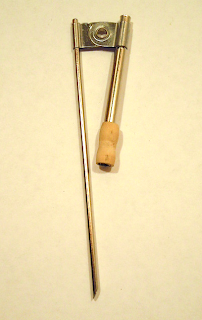For today's elephant, I thought I'd try another oddball Surrealist technique: aerography.
There are many different art-related uses of the term "aerography". Today, it is often applied to anything that has been spraypainted or airbrushed, with or without a stencil. In the early twentieth century, it was sometimes used to describe spraypainted works produced using a stencil. Most commonly, however, traditional Surrealist aerography involves spraypainting over a three-dimensional object.
There is little or no information on who invented the use of three-dimensional objects for aerography, other than to say that it was a Surrealist technique. The artist Man Ray is often cited as having produced aerographs in the 1910s and 1920s, but the only examples I could find used stencils rather than three-dimensional objects. Be that as it may, the official definition of traditional aerography says it involves a three-dimensional object, so that's what I decided to try today.
Not owning an airbrush, and not willing to make such an investment at this point, I bought this inexpensive mouth atomizer, which is an old-school device used to spray varnishes and other media onto paintings and drawings. Having never used such a thing before, I was glad to find some helpful instructions online.
For my three-dimensional objects, I chose three plastic elephants my mother got at a garage sale. I figured it would be better to use these than to potentially ruin something else. The elephant on the right is the same one I used for gyotaku.
For paints, I used bottled acrylics, watered down; and for paper, I used inexpensive 28 x 35.5 cm (11 x 14 inch) sketchbook paper. I found that paints the thickness of cream or buttermilk worked best for this particular technique.
The only difficult part of this is getting the hang of using the mouth atomizer, and even that isn't hard. Essentially, you bend it into an upside-down L-shape, dip the longer end in the paint and blow through the mouthpiece as you move the atomizer across the page. To see a mouth atomizer in action, click here.
I covered my working area with large sheets of bristol board, and laid a piece of paper down with one of the elephants in the middle. Then I simply sprayed across the page with the mouth atomizer, using purple, blue and green paint in succession.
This was a very easy activity, and resulted in about what I expected in terms of final art. With a three-dimensional object, you get softer edges than with a conventional stencil, which I liked. However, a three-dimensional object can also be dicey in terms of providing a full outline of the object. The more dimensional the object, the more diffuse the final image.
I enjoyed doing this, and it doesn't make as much of a mess as I thought it would. It's relatively easy to direct and control the paint, and I like the final look. It's not something I'd want to do every day, but it has a less uniform effect than a spray bottle or an actual airbrush, which was something I found rather appealing.
Elephant Lore of the Day
The most famous landmark in Chambéry, France is the fontaine des Éléphants (the Fountain of the Elephants). Built in 1838, it was erected to honour local hero Benoît de Boigne for his accomplishments in India.
Trained in Europe, de Boigne went to India in the early nineteenth century, where he helped the Maharaja of Gwalior build a massive army based on the European model. De Boigne also became the army's general, commanding a force of nearly 100,000 men. The army enabled the Maratha Empire to dominate central and northern India, and to resist the British for longer than any other princely state. So happy was the Maharaja with de Boigne's efforts that the Frenchman was made a jaghir, which came with enormous land holdings in India.
De Boigne later returned to Chambéry, and devoted the rest of his life to charity work. Upon his death in 1830, he left more than 3 million francs to the town of Chambéry, largely to support education, churches, and the poor.
When the fontaine des Éléphants was erected in the town square in 1838, it was derided by local residents, who nicknamed it les quatre sans culs ("the four without rear ends") because of the way its four elephants were embedded into the base of the column. Designed by French sculptor Victor Sappey, the is topped with a statue of de Boigne.
 |
| The fontaine des Éléphants in Chambéry, France. Photo: François73 Source: http://en.wikipedia.org/wiki/File:Chamberyelephants.JPG |
To Support Elephant Welfare
World Wildlife Fund
World Society for the Protection of Animals
Elephant sanctuaries (this Wikipedia list allows you to click through to information on a number of sanctuaries around the world)
Performing Animal Welfare Society
Zoocheck
Bring the Elephant Home
African Wildlife Foundation
Elephants Without Borders
Save the Elephants
World Wildlife Fund
World Society for the Protection of Animals
Elephant sanctuaries (this Wikipedia list allows you to click through to information on a number of sanctuaries around the world)
Performing Animal Welfare Society
Zoocheck
Bring the Elephant Home
African Wildlife Foundation
Elephants Without Borders
Save the Elephants
















No comments:
Post a Comment